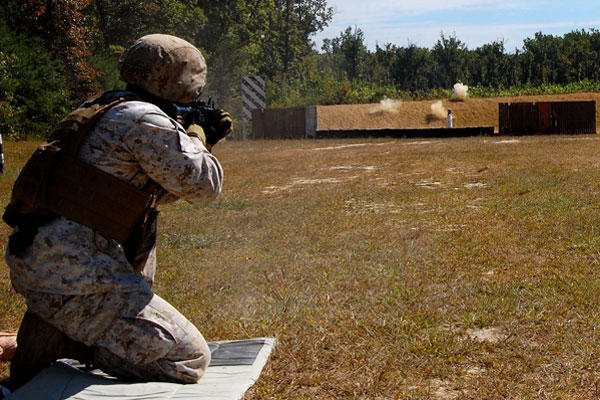QUANTICO MARINE BASE, Va. -- Marine Corps Warfighting Lab officials demonstrated experimental training techniques for shooting moving targets, a battlefield skill that’s all but ignored in the service’s marksmanship training.
If there is one lesson infantrymen have learned in the past decade of war, it’s that the enemy doesn’t stand still and wait to be shot. They sprint between houses and other available cover, often presenting as small a target as possible.
It has always been a battlefield reality of modern warfare, yet Marine Corps and U.S. Army combat training continues to focus on outdated techniques that largely involve stationary targets.
Now Marine Warfighting Lab officials, working with the Army’s Asymmetric Warfare Group, hope to change this by collecting data aimed at finding the best methods for effectively engaging realistic targets that move at speeds seen on the battlefield.
The Sept. 16-27 experiment had a handful of Marine instructors from The Basic School here practicing a series of techniques for hitting moving targets while shooting from the prone, kneeling and standing positions with M4 carbines and the service’s M27 Infantry Automatic Rifle.
They used the tracking method, which involves leading the target before shooting at it. Marines also practiced using the ambush method, which calls for picking a fixed point in front of a moving target and firing as it moves into it.
The third technique is known as the swing through method. The newer technique has the shooter begin firing at the rear edge of the target, moving the muzzle forward to the front while continuing to fire.
The experiment also involved Marines firing in semiautomatic and three-round burst modes from the M4, and full auto from the M27.
Currently, Marine Corps marksmanship training is primarily focused on engaging stationary targets.
“To provide a little framework, as we look at our Table-One and Table-Two marksmanship course, out of 110 rounds that are shot in those tables right now … only eight of those are shot at a moving target,” Capt. B.L. Brewster of the Warfighting Lab’s Field Testing Branch, told a group of Marine officers and senior noncommissioned officers attending the demonstration.
Those targets are 19 inches wide and 40 inches tall and move horizontally for about 10 seconds at a speed of about two miles per hour. The Marine TBS instructors participating in the experiment said such training is ineffective at preparing Marines for combat.
“It’s just unrealistic; there is no gain in it whatsoever,” said Sgt. Phillipi Sanz, who has seen two deployments to Afghanistan and one to Iraq in his eight years in the Corps.
A big part of what makes this new training strategy different is the wheeled robotic targets that are topped with mannequins and move at more than eight miles per hour.
“When it comes out at 8.5 miles an hour, it’s cruising,” said Sgt. Jamie Wieczorek. “It’s a man’s full sprint.”
The robot targets, which present only a 12-inch wide target when moving horizontally, can be programmed to change directions quickly and move for cover like many of the enemy seen in Afghanistan.
“It’s very realistic,” said Sgt. Eduardo Benavides. “[In Afghanistan] you have a house here, you have a house here and they run across the street and you’ve got about five seconds to hit the target and that is what we have here.
“It’s probably the best training I have received since I have been in the Marine Corps because it doesn’t get more realistic than this.”
Sanz agreed with his fellow Marine.
“I wish we had the opportunity to do more stuff like this,” he said. “I enlisted as an infantryman, and we definitely don’t get the opportunity to shoot targets that replicate what we are really going down range to engage.”
The Marines who participated want to see the training pushed out to the entire Marine Corps, but it’s unclear what the next step will be. The robotic targets currently can cost more than $100,000 each, a hard selling point at a time of massive defense spending cuts.
Wieczorek said the Marine Corps should consider adding this as another complete table of instruction to Marine marksmanship training.
To Benavides, it should at least be taught to combat units.
“If you can’t push it down to the whole Marine Corps, then push it down to the infantry units,” he said. “This is what we see. This is what we encounter when we are in combat.”



























